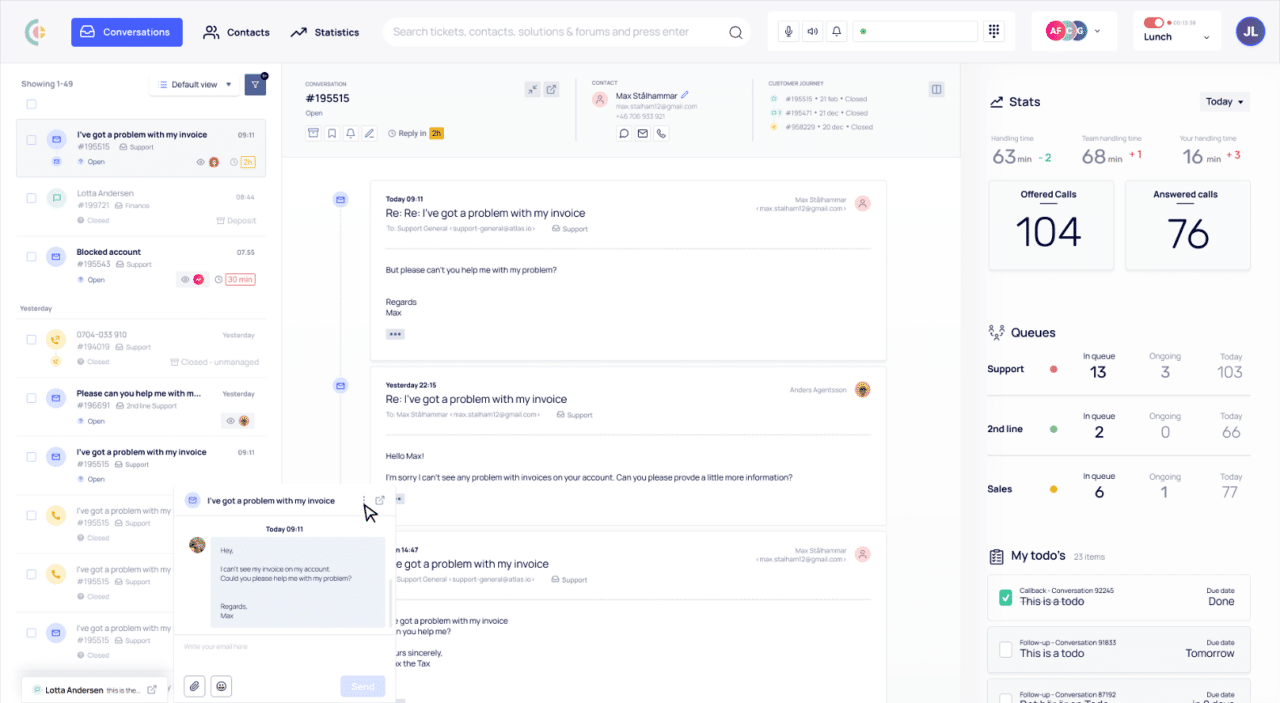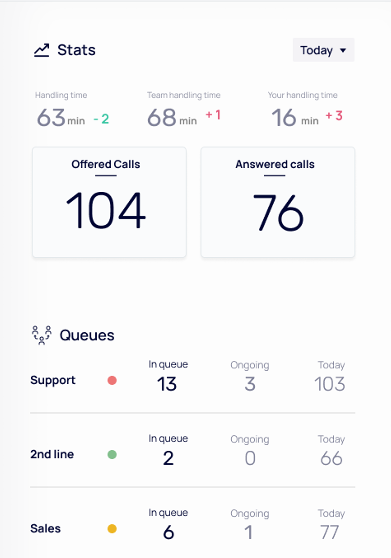

Trends for contact centers 2022
We’re taking a look at what customers and customer service teams value to figure out current trends for contact centers.
Which metrics are most important for contact centers? More and more companies are transferring from an on-premise solution to a cloud based contact center solution. What is the primary reason for this change? What is the main reason a customer will move to a competitor and what factor is so important that it can help you retain 89% of your customers?
1. If a company makes their customers feel valued and appreciated, 76% indicate that they will stay loyal to the brand. 80% say that they will consume more in the future and 87% will recommend the brand to friends and family. (Source: Forrester, 2021)
What really sets you apart from your competitors isn’t necessarily your product or service. A large part of what differentiates you is the customer experience and customer service you provide. Are you available where and when your customers need you? What processes and routines are in place to help make the customer experience as smooth and positive as possible? Do your agents have the resources and trust needed to provide excellent service and support?
2. 82% of companies state that it is cheaper to retain an existing customer rather than to acquire new customers. New acquisitions are as much as 5-30 times more expensive. (Source: Finextra)
Ensure you have a strategy in place and the resources necessary to retain your clients. Could your Customer Service team be the key to success?
3. When a customers issue is solved during the first contact, only 1% will turn to a competitor. If they did not receive sufficient help during their first contact, the probability that they will turn to a competitor increases to 15%. (Source: VOIP-Info.org, 2020)
Ensure that your agents have the necessary training, not only in how to work efficiently in your systems but also in regards to service. Provide your agents with the tools, training and authority to solve your customers issues. This will lead to more satisfied customers and team members who are more fulfilled in their professional role.
4. 95,7% of customer service professionals agree that CSAT (customer satisfaction) is the most important metric. (Source: Call Centre Helper, 2021)
CSAT is definitely an important metric. It is also interesting to compare CSAT with AHT (Average Handling Time) and ASA (Average Speed of Answer). To be honest, there are hundreds, if not thousands of relevant metrics for customer service, which makes it difficult to know where to start. If you want to deep-dive into the world of metrics and KPI’s, we recommend starting with our guide: The KPI formula to customer service success.
From on-premise to cloud based solutions
5. The ASA (Average Speed of Answer) can be decreased by up to 50% by transferring to a cloud solution. (Source: Ringcentral)
There is a common misconception that cloud based solutions are unsafe and unstable. We have instead seen the opposite. Cloud services are more often very stable environments to work in, more so than on-prem solutions.
6. Of those who had switched from an on-premise solution to a cloud based solution, 91% experienced that the agents had less downtime and increased efficiency. (Source: Salesforce)
The most common reason for not switching to a cloud based solution is that people believe on-premise is more secure. Cloud based solutions have instead proven to have a kind of natural redundant environment that is beneficial for businesses to operate in.
7. 90% stated that the primary reason for transferring to a cloud based solution was financial flexibility. (Source: Aberdeen Group)
Cloud solutions have a scalability that enables you to quickly adapt to increased volumes. If your business suddenly experiences a growth spurt, or if you have seasonal peaks that put pressure on your contact center solutions, you need to be able to adapt fast so that you keep both agents and customers happy.
An omnichannel strategy
8. 59% are more satisfied with companies that answer customer service-related questions and complains through social media platforms. (Source: Statista)
In large part because of social media and chat tools, the average amount of incoming messages has doubled. Customers expect you to answer their questions through the channel of their choice, not the channel you choose for them.
9. 49% will use on average 3 – 5 different channels to get in contact with customer service. (Source: Microsoft Dynamics 365, 2020)
With an omnichannel solution you are able to meet and communicate with your customers on multiple channels without losing oversight of the customers history and data. Customers value being able to choose a channel or medium depending on their current needs. In order for your agents to work efficiently, this requires a contact center solution that can gather all incoming errands in one platform and interface.

10. 89% will stay loyal to a brand because that company has a strong omnichannel strategy. (Source: Invesp, 2019)
Customers will change between channels depending on time of day, what their errand is and how available they are at the moment. If they have to repeat themselves over and over again, friction will occur. Ensure that you are able to meet the customer wherever they prefer, and choose a customer service solution that allows you to gather all incoming errands, as well as customer data, in one place.
11. Despite the development of automated solutions such as IVR, chat bots and voice bots, 75% of customers still prefer direct contact with a human being. (Source: Customerthink)
In some cases it is both quicker and easier with automated solutions. The downside to chat bots and voice bots are that they lack human empathy. It is therefore important to have an omnichannel solution so that you provide different ways of contacting your customer service team, enabling the customer to choose the medium they prefer at that moment in time.
12. 70% prefer companies who proactively send customer service related information. (Source: Statista)
Receiving notice that your delivery is delayed is never fun. However, your clients will appreciate being told in advance. Go through your customer journey and consider if and where there is room for proactive communication with your customers. There might even be situations where you can decrease the amount of incoming errands as a result of proactive communication.
13. On average, 75% of errand handling time (direct contact with agent) is spent on finding the customer’s information. (Source: IBM)
One of the major challenges for businesses today is tech silos. It’s becoming increasingly important to have systems and solutions in place that are able to communicate with each other and share data. Your agents should be spending their time providing high quality service, not searching through databases.

Summary
Current trends within contact centers and customer service are that companies will transfer to cloud based customer service solutions and that an omnichannel strategy will be crucial to deliver a great customer experience.
In order for clients to receive the service level that they have come to expect, contact centers must have a system in place that can gather errands from all channels in the same interface. This is necessary to ensure that the customers history is visible to the agent so that they have all necessary information immediately. If the agent needs to switch between systems there is a risk that they will miss certain facts or details that in turn can cause friction in the customer service experience. By connecting all your channels and alla your data in one platform, you have the technological conditions in place to deliver world class customer service.
View demo to gain insights into the platform and popular functions such as dialer, drag-and-drop IVR, chat bot, voice bot and survey.


